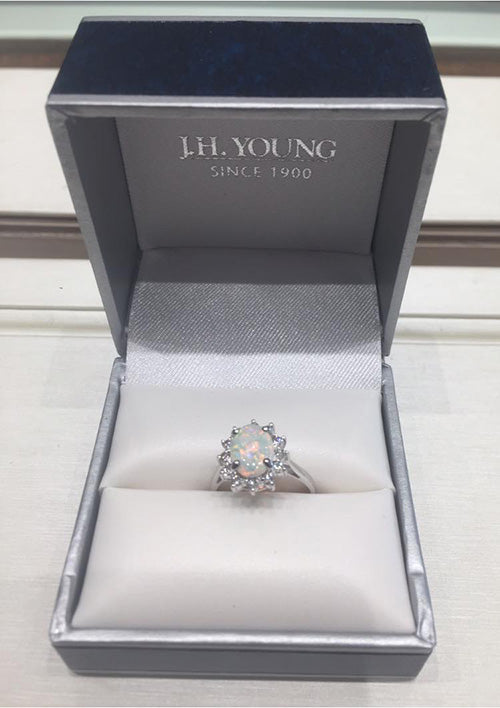Opal Jewellery 101
Diamonds make elegant and durable gems to buy, gift or own but you may find two diamonds that look alike. In contrast, two opals will never look alike.
Every single opal is unique in its pattern and rainbow of colours. This means that you can own a stone that’s one-of-a-kind in the whole world, just like your personality.
Looking to gift yourself or someone in your life a unique gem? Keep reading to find out what to look for when buying opal jewellery.
But first…
What is an opal?
Let’s start with the basics and get a bit technical about what kind of stone an opal. Opals are made of microscopic spheres of silica and typically contain about 3% -10% of water. Silica is the main mineral that reflects light and displays play of colour (we will explain this a bit later) that makes these stones unique.
Opals are classified into:
1.Common Opals
They are also known as potch and do not show the play of colour. Common opals come in a variety of colours and are quite attractive but not used as jewellery.
2. Precious Opals
These stones, also known as “noble opal” are the ones that are treated as jewellery. Precious opals exhibit the “Play-of-colour”, which is the familiar flash of bright colourful light that a person sees when viewing an opal.
There are several types of opals to choose from. Some of the most common ones are listed below:
- White Opal
- Black Opal
- Boulder Opal
- Crystal Opal
- Fire Opal
- Ethiopian Opal
- Harlequin Opal
What are the value factors for Opal?
Opals are classified and priced according to the overall body colour, their unique play of colour, and the transparency displayed by each gem. While these may sound like a bunch of technical terms. They are all factors that determine the value of each stone.
The most important factors are explained below, which will assist you in finding a gem you love.
1. Play of Colour
Play of colour is an optical phenomenon that occurs when opal is moved around in the light. The more the colour changes, the more valuable the stone.
Play-of-colour occurs when light enters an opal, interacts with its internal structure, and leaves the opal in a flash of spectral colours. A single piece of opal can have an almost unlimited number of appearances.
The density, intensity, and distribution of these colour flashes are the determining value factors.
When buying opal jewellery, it’s best to see the stone in-person to see the colour change. When you’re at the jewellery store, make sure you ask them to move the opal around to see the play of colour for yourself.
2. Body of Colour
The body colour is the base colour of the opal.

It can be difficult to see the body colour when it comes to opal jewelry. The best way to see it is to lay the opal down on a flat surface and look at it from directly above. Typically, the darker the base colour, the more valuable the stone. This is because the dark base can better showcase the reflective colours in the stone.
Like other measuring scales there is one to determine the body colour of opals. The value on the scale ranges from N1 (most valuable) to N9 (least valuable). It’s important to note the body colour and stay upwards of N9 when buying an opal.
3. Transparency
Opals may be anything from crystal clear to completely opaque. The value of an opal is determined by its level of transparency. There are three classifications for an opal’s transparency:
- Opaque opals are the least valuable as you cannot see through the stones let alone its colours.
- Translucent opals allow some light to pass through and are somewhat valuable.
- Transparent opals are the most valuable as you can see right through them.
What is doublet and triplet in opal jewellery?
No, we’re not talking about twins. Opals are brittle stones and will require a protective layer to stay durable. The techniques used to protect opals are called a doublet and a triplet.
Giving opals a backing layer in a different material is called a doublet. Usually, this layer is made from either glass or obsidian (a naturally occurring volcanic glass formed as an extrusive igneous rock). The benefit of a doublet is that the colours of the opal will be brighter because of the darker background.
A triplet is an additional protective layer over the opal. Essentially there will be three layers: a backing (doublet), the opal itself, and a clear cover (triplet) like glass, plastic or crystal.
What are natural faults in opals?
Nothing is perfect in this world. Similarly, opals will have a natural fault in them called an inclusion. An inclusion is a line inside the rock that forms against the grain.
An inclusion is different from a crack. At J.H Young, we can help you check for inclusions by holding the opal against the light with a microscope.
—
Knowing all these characteristics of an opal means you are now well equipped with the knowledge to go shopping for some unique opal jewellery for yourself.
Since opal is a precious stone, it should be bought in a precious metal setting at J.H Young. Our trained staff will help you check for all the value factors.
If you are looking to learn more about opal jewellery, you can always consult with our talented staff at J.H Young in Brantford. Come visit our renovated store and browse through our immense selection.





